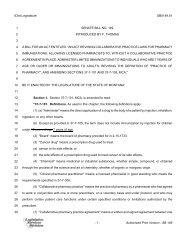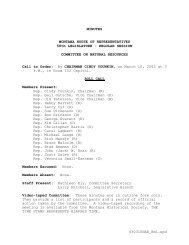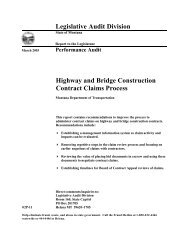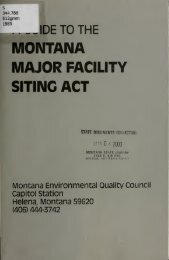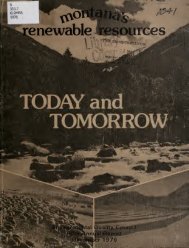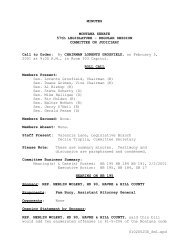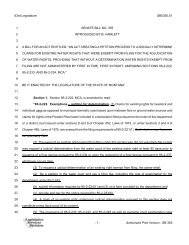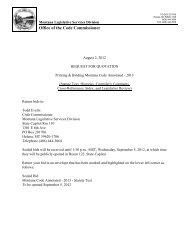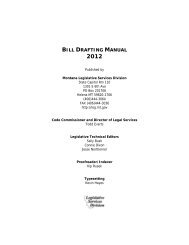Public Comment. Volume III - Montana Legislature
Public Comment. Volume III - Montana Legislature
Public Comment. Volume III - Montana Legislature
You also want an ePaper? Increase the reach of your titles
YUMPU automatically turns print PDFs into web optimized ePapers that Google loves.
States, yet since 1986, pipelines were responsible<br />
for only sixteen percent (16%) of the total volume<br />
of oil spilled to waterways by all modes of<br />
transportation.<br />
Technological and operational advances<br />
continually improve the safety record of pipelines.<br />
How do Oil Pipeline Companies Prevent Pipeline<br />
Leaks?<br />
There is a strong system of regulatory<br />
requirements aimed directly at both preventing and<br />
responding to oil spills from pipelines. In addition<br />
to pipeline design and construction requirements,<br />
pipelines must be operated according to strict<br />
rules. Pipeline companies must maintain a manual<br />
of written operating procedures to ensure the safe<br />
operation of the pipeline. Damage prevention<br />
programs are in place, which include awareness<br />
activities involving the public, local government<br />
officials, and excavation contractors. All <strong>Montana</strong><br />
pipelines participate in a "one call" location network<br />
("call before you dig" program), which provides<br />
notification to the pipeline of any planned drilling or<br />
excavating activities in the vicinity.<br />
By regulation, a pipeline carmot be operated at<br />
pressures above those that have been<br />
demonstrated to be safe by engineering<br />
calculations and pressure testing.<br />
Cathodic protection systems are maintained and<br />
inspected at regular intervals to prevent corrosion.<br />
Instrumented internal inspection devices called<br />
"smart pigs" are regularly sent through the pipeline<br />
to check for weakness or corrosion. Valves and<br />
pressure relief systems also are regularly inspected<br />
and maintained. Numerous other inspections are<br />
routinely made, and extensive documentation of<br />
the inspections is kept.<br />
Similar to the requirements for truck drivers and<br />
airline pilots, all pipeline employees who perform<br />
"safety sensitive" functions participate in a<br />
mandatory drug and alcohol-testing program to<br />
prevent impairment-induced accidents.<br />
Is There a System in Place to Respond to Pipeline<br />
Spills ?<br />
Pipeline companies must comply with the<br />
requirements of the federal Oil Pollution Act. The<br />
Oil Pollution Act is directed at reducing the risk of<br />
oil spills, and at mounting a prepared response if<br />
one should occur.<br />
Detailed, written oil spill plans are required, which<br />
must be approved by governmental agencies, and<br />
are reviewed regularly by Department of<br />
Transportation. Pipeline operators must<br />
demonstrate that adequate spill response and<br />
recovery resources (including personnel and<br />
equipment) can be mobilized and deployed within<br />
certain time periods defined by regulation for three<br />
tiers of oil spill sizes, including the worst case<br />
scenario. The worst-case scenario involves a<br />
maximum spill quantity under worst-case<br />
mobilization and response conditions.<br />
Pipeline companies do extensive training and<br />
practicing to ensure that their spill response<br />
systems stay sharp. Some of the exercises include<br />
emergency responders from local, state and<br />
federal governmental agencies, which facilitates<br />
better understanding of each other's roles and<br />
capabilities in the unlikely event of a pipeline<br />
incident.<br />
Can a Landowner be Held Liable for Environmental<br />
Damage From a Pipeline Oil Spill?<br />
Priorities in the event of a spill are safety of the<br />
public and protection of the environment. The spill<br />
is contained, repairs are made, environmental<br />
restoration occurs, and an investigation into the<br />
cause of the release is made. 'The cleanup and<br />
investigation is conducted in conjunction with<br />
appropriate regulatory agencies. In the event that<br />
the investigating team proves there was damage to<br />
the pipe as a result of negligence on the part of a<br />
third party, such as a landowner, charges can be<br />
made against the third party.<br />
Crude Oil A Petroleum<br />
Product Pipelines in <strong>Montana</strong><br />
EQC Eminent Domain Study -1 73-<br />
Page 3



